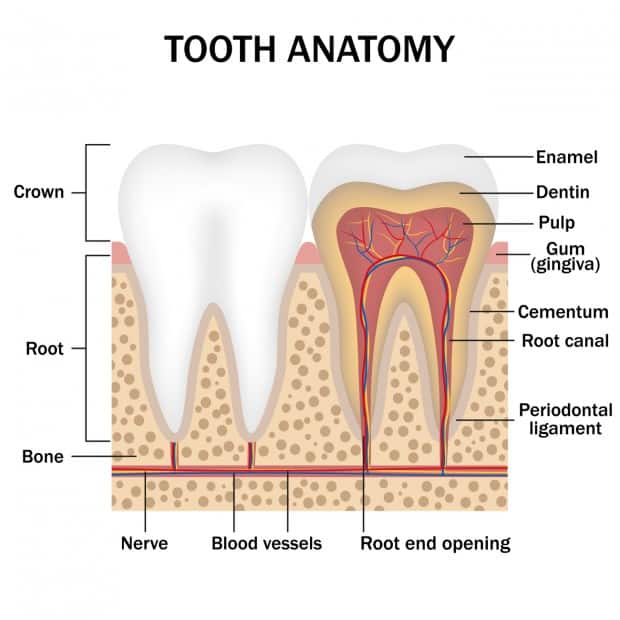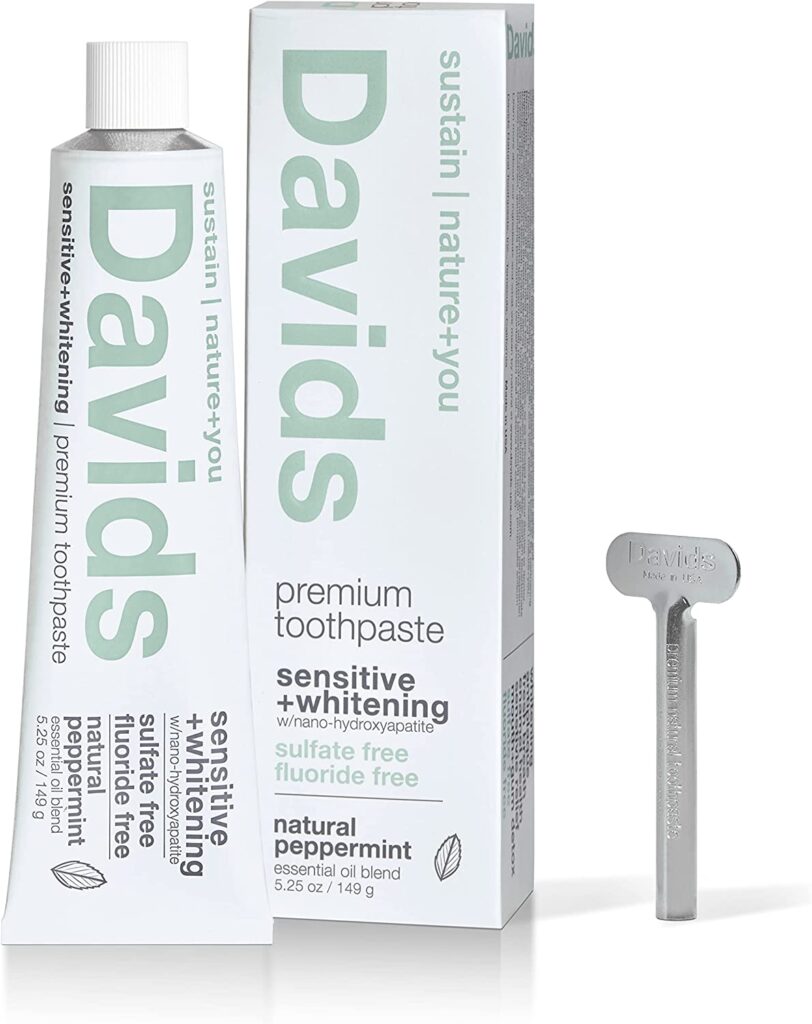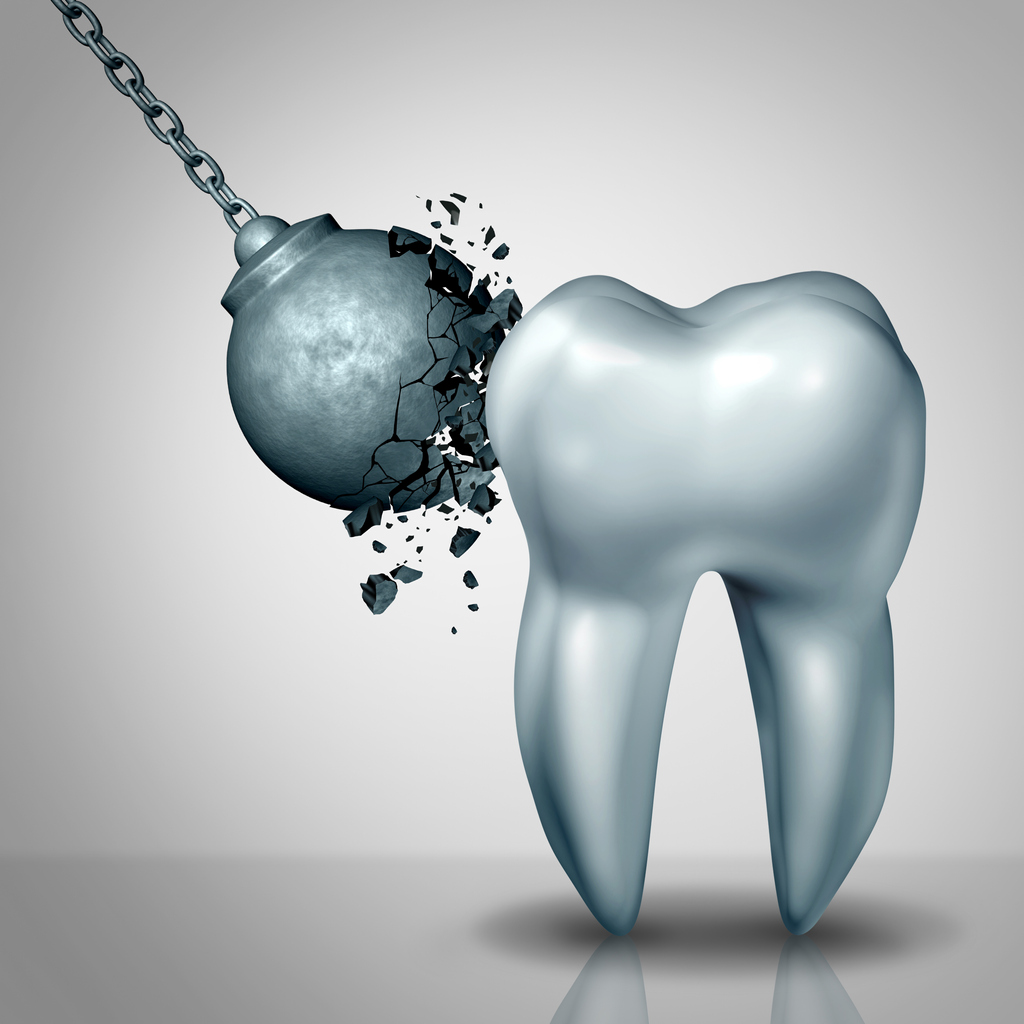When it comes to the human body, we often marvel at the resilience and strength of our bones and teeth. After all, these structures form the foundation of our ability to move, chew, and communicate. When it comes to the strength of our body’s structures, we often think that bones are the strongest and most durable. But what about our teeth? Are they just as strong, or do they fall short of it when compared to our mighty bones?
The answer is that pound for pound, the teeth are much stronger than the bones. This is primarily due to the composition of the teeth which makes it the hardest substance in the human body. The tooth enamel, which is the outer covering of the tooth, is made up of 95% minerals, 4% water, and 1% protein. The main mineral present (~90%) in the enamel is hydroxyapatite, a form of apatite which comprises of calcium, phosphate and water. The high percentage of hydroxyapatite makes a tooth incredibly strong and durable.

While hydroxyapatite is present in both the teeth and the bone, only 65% of the latter is made up of this mineral. The remaining 35% are made up of other organic substances such as type I collagen (~90%) and non-collagenous proteins (~10%). Yet, it is these organic components that gives bones their flexibility as compared to the teeth.
Through this comparison, we can understand that the higher concentration of hydroxyapatite in teeth makes it a much stronger substance than the human bone.
In the rest of this article, we will take a deep dive into the strength between the teeth and bones, and understand the difference between the two hardest substance in the human body.
Comparing the Strength of Teeth and Bones
Teeth and bones are both important components of the skeletal system in the human body, but they have different functions. Teeth are mainly used for breaking down food, the bones protect our organs, provide structure, and allow us to move.
While we can conclude that the tooth is stronger than the bone, you may have wondered just how strong a tooth exactly is, and how it compares against the bone.
The amount of pressure that a bone can withstand can varies based on a number of factors, including the type of bone, its density, its size and shape, as well as the age of the bone. In general, it takes about 1700 pounds per square inch (PSI) to break the human femur.
For comparison, it takes about 2,000 to 5,000 PSI to break traditional concrete while steel have a strength of up to 40,000 PSI.
The teeth, which are designed to tear through meat and tough plants, can handle around 150 to 200 PSI when the teeth is clenched. However, the average human tooth can withstand up to 20,000 pounds of force before it breaks.
You may be interested in: What Are The Benefits Of Keeping Wisdom Teeth?
As previously mentioned, the strength of the tooth and the bone is due to the high concentration of hydroxyapatite. This mineral belongs to a group of phosphate called Apatite which has a Mohs Hardness Scale of 5.

The scale is a widely recognized test designed to measure the hardness of a mineral, with 1 being the least hard (e.g Talc), and 10 being the hardest (e.g Diamond). For reference, iron and has a Mohs scale of 4 to 4.5 while glass measures 5.5 on the scale.
While the tooth scores well in terms of hardness, it is much more brittle than steel and can chip easily. Furthermore, the strength of the tooth is compromised when it suffers from demineralization, a condition where the minerals (including hydroxyapatite) are attrited from organic acids produced by plaque.
Differences Between Teeth and Bones
While both share several commonalities including their color and composition, teeth are not bones. In fact, the teeth and the bones differ greatly in their properties:
- Regeneration: The tooth cannot regenerate once it is lost, so teeth are unable to repair themselves. In contrast, bones have a remarkable ability to repair themselves through a continuous process of resorption and deposition of bone material. This allows bones to repair fractures and maintain strength throughout life.
- Remodelling: Similarly, the tooth cannot undergo any form of remodelling. While a teeth can shift under certain circumstances (e.g grinding of teeth, braces), its structure remains largely unchanged. On the other hand, when under stress, bones undergo modification and adapt to changing mechanical load.
- Sensitivity: The innermost part of a tooth, the pulp, contains nerves and blood vessels, making teeth sensitive to external stimuli such as temperature, pressure, and decay. Bones are generally less sensitive to external stimuli due to their dense structure and lack of nerves within the bone tissue itself
- Life-saving Cells: Bones contains the bone marrow, a soft, spongy tissue. Bone marrow produces hematopoietic stem cells, an “immature” cell which transforms into red blood cells, white blood cells, and platelets. This is absent in the tooth.
- Growth: Humans have two sets of teeth throughout their lifetime: deciduous teeth (baby teeth) and permanent teeth (adult teeth). Tooth development begins in the womb and continues through childhood. However, once the teeth have fully developed, they do not grow anymore. On the other hand, humans only have one set of bones and they develop throughout childhood, reaching peak bone mass in adulthood.
These differences in properties between bones and teeth arise from their unique compositions and structures, which in turn determine their specific functions in the human body.
It is important to note that bones can become stronger with regular exercise and physical activity, while teeth can become weaker due to factors such as decay and injury. Vice versa, bones can become weaker due to osteoporosis while teeth can become stronger from remineralization.
Over the past decades, many oral health manufacturers have came up with various ways to aid the remineralization of the tooth.
Hydroxyapatite Toothpaste
As hydroxyapatite makes up over 90% of a tooth composition, toothpaste manufacturers have produced hydroxyapatite toothpaste to aid with the remineralization of the tooth.
These toothpaste are made with synthetic hydroxyapatite (HAp), a biocompatible and bioactive material that was invented in the 1990s to replicate the organic hydroxyapatite. The inclusion of hydroxyapatite in toothpaste can help repair early stages of tooth decay, strengthen teeth, and reduce tooth sensitivity. It work by having the hydroxyapatite particles bind to the tooth surface and filling in the microscopic gaps or defects in the enamel, thereby restoring the mineral content and integrity of the tooth.

Davids Nano Hydroxyapatite Natural Toothpaste
Some of the popular hydroxyapatite toothpaste in the market include:
- Boka Coco Ginger (Nano-Hydroxyapatite) Natural Toothpaste
- Davids Nano Hydroxyapatite Natural Toothpaste
- Apagard Premio (Nano-Hydroxyapatite) Toothpaste
- PerioSciences Natural Toothpaste
- Dr. Brite Healthy Smile Toothpaste
Hydroxyapatite toothpaste is considered a safe and effective alternative to fluoride toothpaste. While fluoride is commonly used in toothpaste to strengthen enamel and prevent tooth decay, some people may have concerns about its safety or experience sensitivity to fluoride. In such cases, hydroxyapatite toothpaste can offer a natural, biocompatible option for maintaining oral health.
Takeaway
In summary, both teeth and bones possess unique properties that contribute to their strength, and they can withstand a significant amount of force.
However, it’s important to recognize that strength is not the only factor to consider when comparing teeth and bones. While teeth excel in hardness, they are also more brittle and susceptible to chipping or cracking under excessive stress or impact. Bones, on the other hand, are not as hard as enamel, but they have a unique combination of strength and flexibility due to their composition of collagen fibers and hydroxyapatite. This allows bones to withstand various forces, support body weight, protect vital organs, and facilitate movement.
That said, maintaining good oral and overall health is critical to ensure that both teeth and bones can continue to perform their vital roles in our lives.





